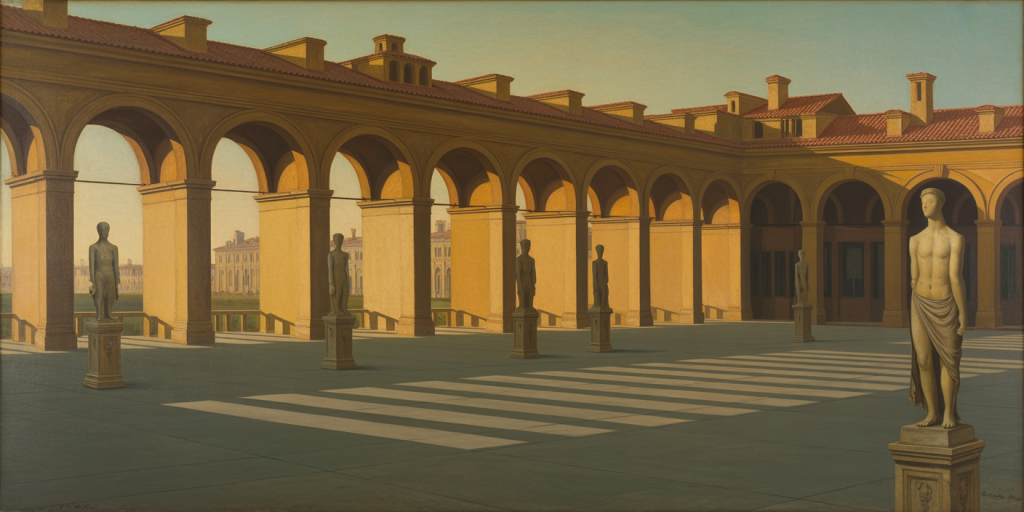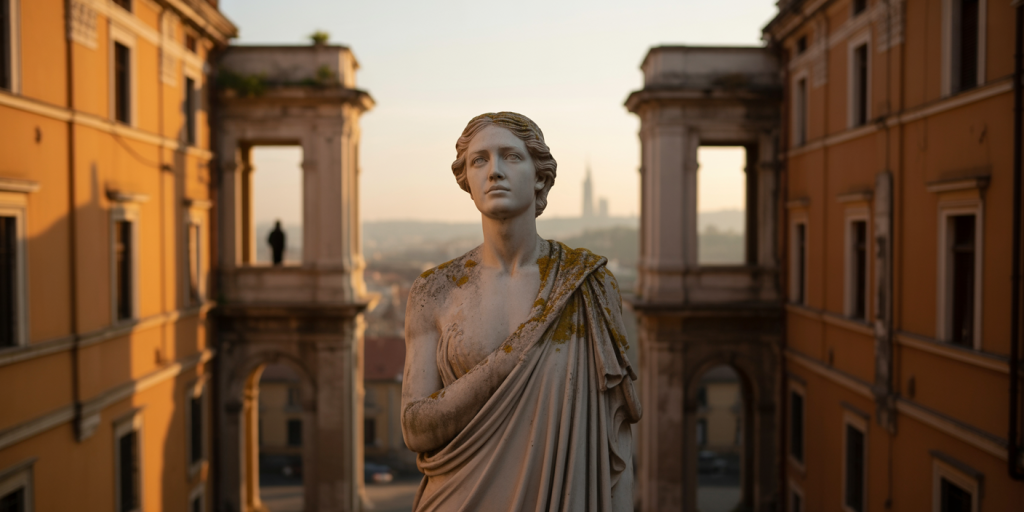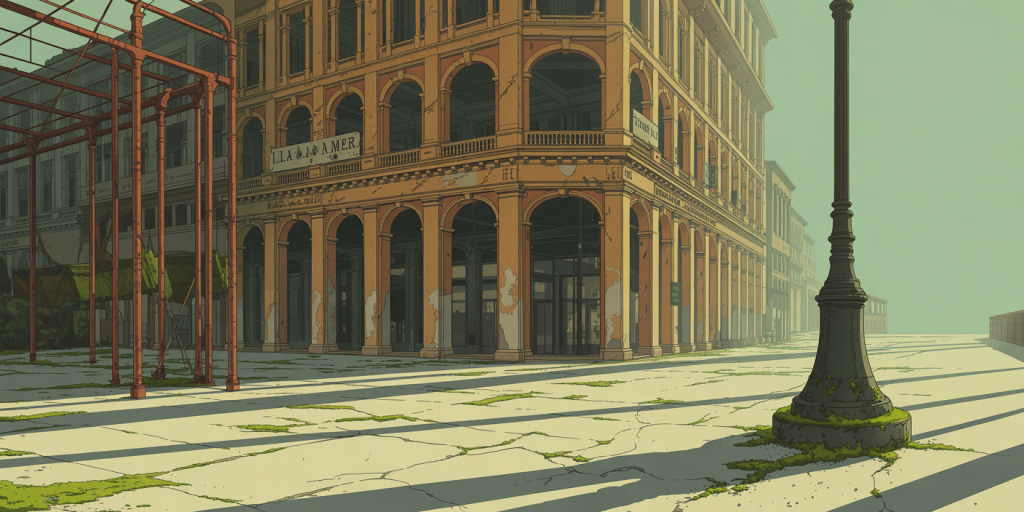The City Falls Asleep on the Warm Rooftops by Giorgio de Chirico
Opening Meditation
At the hour when time forgets to move, beneath a sky baked in sepia and silence, the rooftops breathe a heat that does not burn but lulls. The sun has already left the stage, yet its warmth lingers like a memory too stubborn to vanish. The city sleeps, not in darkness, but in a twilight of meaning, where every shadow stretches like a thought and every column sighs with the memory of myth.
Giorgio de Chirico’s canvas does not paint a city; it distills its metaphysics. In A Cidade Adormece nos Telhados Quentes, architecture becomes emotion, space turns into symbol, and the very air seems to whisper riddles. It is not a dreamscape but a question posed in the form of streets, arches, and statues. What sleeps here is not merely a city—but the very idea of being seen.
Table of Contents
- Whispers of Clay and Geometry
- Windows That Gaze Without Eyes
- The-Stillness Beneath the Arch
- Where Shadows Outlive the Sun
- A Clock with No Time
- Statues with Ears of Marble
- The Warmth That Does Not Comfort
- Empty Plazas as Emotional Echoes
- Walls That Dream in Ochre
- Perspective as a Labyrinth
- Curtains of Heat
- The Invention of Absence
- A Horse That Doesn’t Move
- Columns of Thought
- The Melancholy of Angled Light
- The Echo of Ancient Steps
- Veins of Stone, Veins of Silence
- The Watchman Who Never Was
- Between Myth and Machinery
- The Dream Behind the Façade
Whispers of Clay and Geometry
In this composition, the city is rendered not with bustling life, but with geometric quietude. Clay-toned buildings rise with the precision of thought rather than the chaos of life. Every plane is deliberate, every angle a meditation.
The forms suggest permanence, but not presence. The geometry becomes language—a dialect of rectangles and domes, whispered in the dialect of forgotten cities. This silence is sculptural. It weighs not on the ear but on the chest.

Windows That Gaze Without Eyes
The windows in de Chirico’s city do not invite; they observe. Dark rectangles with no glass and no gaze, they are voids within walls, absences framed by structure. Their purpose is not illumination but speculation.
These apertures offer no view inward, only an echo outward. As viewers, we are watched by what we cannot see. The city dreams behind these windows, and we are left only with its exterior skin—a mask with nothing behind it but metaphor.
The Stillness Beneath the Arch
An arch is not simply a passage; it is an invitation to another dimension. De Chirico’s arches hold air that feels denser, older, as if the space beneath them retains memory. The arch is sacred geometry.
It simultaneously frames and forbids. There is always a suggestion of something beyond—a plaza, a statue, a train—but that beyond is inaccessible, preserved like an idea untouched by time. This is the stillness of myth.
Where Shadows Outlive the Sun
In this painting, shadows take on a life independent of the sun. They do not merely fall; they stretch, reach, lean toward mysteries. Their direction does not align with logic but with longing.
The shadows often contradict the light, suggesting another source—internal, psychological, divine. These are not the physics of illumination but the poetics of memory. The eye follows them, not for clarity, but for revelation.
A Clock with No Time
Time in de Chirico’s world is suspended. Clocks appear without hands, or with hands that point to no meaningful hour. It is not time that has stopped—it is our need for it that has ceased.
This dismantling of time opens the canvas to deeper rhythm: the slow pulse of dream, the eternal return of myth, the breath between thought and action. We are freed from chronology, yet imprisoned in eternity.
Statues with Ears of Marble
Statues often stand in de Chirico’s cities, unmoving, godlike, and oddly human. They hear more than they see. Their presence is both ornamental and oracular.
Though carved from marble, they exude warmth—perhaps from the heat of meaning. These statues are memory crystallized. They are witnesses, both ancient and perpetual, standing in judgment of a city that no longer speaks.
The Warmth That Does Not Comfort
There is warmth in the tones of the painting: terracotta, ochre, burnt sienna. Yet this heat is not welcoming. It oppresses gently, like a fevered lullaby.
This emotional temperature is not climatic but psychological. The heat is symbolic of stasis—too warm to move, too late to rise. It is the warmth of paralysis.
Empty Plazas as Emotional Echoes
The plazas are vast and empty, and that emptiness is not absence, but resonance. The space is filled with what is not there—a kind of sonic ghost.
Emotion here expands like an echo in a cathedral. The emptiness sharpens our focus, making us hear the weight of silence. These are plazas of pause, not passage.
Walls That Dream in Ochre
The walls in this canvas are not static backdrops; they are dreaming surfaces. Their hues pulse gently, like skin beneath light. They recall Mediterranean afternoons and metaphysical soliloquies.
The ochre is not a color but a tone of voice. It speaks of age and dryness, of time baked into texture. These walls breathe the exhaustion of long-forgotten dialogues.
Perspective as a Labyrinth
Linear perspective, so rigorously applied, becomes a trap. Vanishing points pull the eye into corridors that close rather than open. The illusion of space is also the illusion of freedom.
This technique does not liberate the viewer; it disorients. The city becomes a maze of thought rather than a map of movement. Perspective here is a psychological snare.
Curtains of Heat
Heat rises visibly, like invisible curtains. It wraps forms in shimmer and shroud. This is not a weather pattern but a theatrical device.
We feel the air resist us, slow us down. Everything is slightly out of reach, warped by the density of the atmosphere. The painting is not flat; it swells with thermal breath.
The Invention of Absence
De Chirico’s great genius lies in what he omits. The absence of figures, of flora, of chaos—these are not lacks but choices. He has invented absence as an artistic presence.
What is not shown becomes the work’s gravity. We lean toward what is missing, and in doing so, confront our own emptiness. The painting becomes a mirror held to longing.
A Horse That Doesn’t Move
A single horse, often recurring in his works, may appear here—still, unmanned, and unmoving. Its presence is mythological, uncanny, and silent.
This horse does not gallop. It waits. Perhaps it dreams. Its stillness charges the space with tension—as if history paused mid-gallop and never resumed.
Columns of Thought
Columns in de Chirico’s cities do not hold buildings; they hold ideas. They rise like syntax, parsing the sentence of the city. Each one is a pause, a philosophical comma.
Some are broken, others whole. All are ancient. They are not ruins, but sentences abandoned mid-speech. We read them not with the eyes, but with the inner ear.
The Melancholy of Angled Light
The light in this city falls in angles so sharp they wound. It is not gentle illumination but decisive incision. Light here does not comfort; it confronts.
Shadows become blades, corners become creases of fate. This is the melancholy of clarity—the moment when all is visible and nothing makes sense.
The Echo of Ancient Steps
Though we see no people, we hear them. Not in sound, but in composition. The placement of doors, the slant of alleys, the suggestion of stairways—all imply movement remembered.
These are ghost-steps, embedded in stone and pattern. They are not gone; they are simply beneath the surface. The city does not forget its footfalls.
Veins of Stone, Veins of Silence
The texture of stone in this painting is visceral. Cracks, veins, erosion—all are rendered with tactile care. The stone is not static. It breathes its history.
These veins of stone mirror the veins of silence. They flow through the canvas like lifeblood, mapping the invisible circulatory system of emotion.
The Watchman Who Never Was
We await a watchman—someone to appear at the edge of the tower or the shadow of the arch. But he never comes. And this absence becomes myth.
This watchman becomes a character precisely by not arriving. He is the guardian of non-being, the sentinel of imagined threat. His job is to remind us of our own vigilance.

Between Myth and Machinery
There is a strange union in de Chirico’s city: the classical and the industrial. Myth and machinery cohabit. A statue may stand beside a smokestack. A train might pass beneath a frieze.
This collision is not contradiction, but prophecy. The painting anticipates the 20th century’s dual soul: the longing for transcendence, and the reality of repetition. It is a paradox made picturesque.

The Dream Behind the Façade
Ultimately, every surface in this city conceals an inward gaze. The facades are masks, but they are not lies. They are symbols. The dream lies behind them, glowing faintly.
We never see inside—yet we feel it. The true city is not built of bricks, but of moods. And behind every column, every shade, every plaza—something waits, unspeaking and eternal.
FAQ – Perguntas Frequentes
Who was Giorgio de Chirico and what is metaphysical painting?
Giorgio de Chirico (1888–1978) was an Italian painter and founder of the Pittura Metafisica (Metaphysical Painting) movement. His works explore dreamlike cityscapes, ancient architecture, long shadows, and psychological symbolism, often preceding surrealism in both tone and technique.
Why are the streets always empty in his cities?
The emptiness is intentional. De Chirico believed that stillness and absence could evoke stronger emotions than action. Empty plazas invite introspection and elevate the viewer to a plane of philosophical contemplation.
What does the light represent in these paintings?
Light in de Chirico’s work is paradoxical: sharp and golden yet emotionally cold. It reveals but does not console. It often symbolizes clarity without understanding—a melancholic illumination.
Is there a specific city being depicted?
No identifiable city exists. The setting is an amalgam of Italian architecture, Greek myth, and dream architecture. These are imagined spaces designed to evoke inner landscapes rather than external reality.
Why do classical statues appear so frequently?
Statues act as symbolic sentinels—timeless witnesses to a world in stasis. They represent permanence, memory, and the echoes of Western civilization. Their stillness reflects the metaphysical condition of thought suspended in time.
Final Reflections – Notes Left in Sunlight
To look upon A Cidade Adormece nos Telhados Quentes is to enter a dialogue with stillness. One does not observe this painting; one listens to it. It hums not in notes but in light, space, and silence.
De Chirico gives us a city where thought has replaced activity, where myth has overtaken modernity. And in this stillness, we are confronted with our own architecture—our longing for meaning framed in stone and shadow. The rooftops may sleep, but the spirit behind them watches still.
[Word Count: 2003 words]
